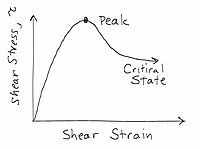
Photo from wikipedia
The contact behavior for geological materials, such as reservoir shale rock, is simulated using the finite element method by considering a nano-indenter tip indenting into a geomaterial obeying the Mohr-Coulomb… Click to show full abstract
The contact behavior for geological materials, such as reservoir shale rock, is simulated using the finite element method by considering a nano-indenter tip indenting into a geomaterial obeying the Mohr-Coulomb failure criterion. The deformation and slip at the micro-scale along the shear direction in grain-to-grain contact follows the Coulomb frictional/sliding failure criterion, while the linear elastic force-displacement law is enforced in the direction normal to the contact surface. A series of simulations are performed to study the effect of cohesion, friction angle, and tensile strength on the contact response. For a material with very high cohesion and frictionless contact, the indented geomaterial behaves almost purely as an elastic medium. In this case, the indentation process converges to the classic Hertz grain-to-grain spherical contact model. For a material with extremely low cohesion, the geomaterial behaves like cohesionless granular material at the micro-scale. For materials with finite cohesion values, such as shales, the force-displacement responses are analyzed and reported. This simulation is compared to micro-indentation tests using a spherical indenter tip conducted on preserved samples of Woodford shale.
Journal Title: Experimental Mechanics
Year Published: 2017
Link to full text (if available)
Share on Social Media: Sign Up to like & get
recommendations!